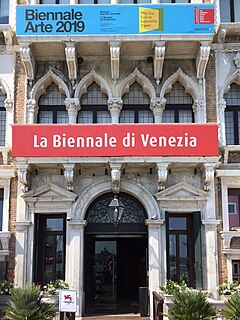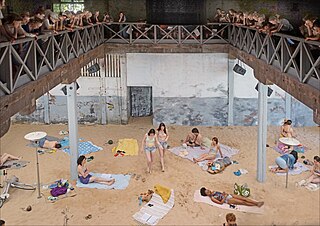
The Venice Biennale is an arts organization based in Venice and the name of the original and principal biennial exhibition the organization presents. The organization changed its name to the Biennale Foundation in 2009, while the exhibition is now called the Art Biennale to distinguish it from the organization and other exhibitions the Foundation organizes.
The 56th Venice Biennale was an international contemporary art exhibition held between May and November 2015. The Venice Biennale takes place biennially in Venice, Italy. Artistic director Okwui Enwezor curated its central exhibition, "All The World's Futures".
The 57th Venice Biennale was an international contemporary art exhibition held between May and November 2017. The Venice Biennale takes place biennially in Venice, Italy. Artistic director Christine Macel, the chief curator at the Centre Pompidou, curated its central exhibition, "Viva Arte Viva", as a series of interconnected pavilions designed to reflect art's capacity for expanding humanism. The curator also organized a project, "Unpacking My Library", based on a Walter Benjamin essay, to list artists' favorite books. Macel was the first French director since 1995 and the fourth woman to direct the Biennale. A trend of presenting overlooked, rediscovered, or "emerging dead artists" was a theme of the 57th Biennale.
The 55th Venice Biennale was an international contemporary art exhibition held in 2013. The Venice Biennale takes place biennially in Venice, Italy. Artistic director Massimiliano Gioni curated its central exhibition, "The Encyclopedic Palace".
The Belgian pavilion houses Belgium's national representation during the Venice Biennale arts festivals.
The Brazilian pavilion houses Brazil's national representation during the Venice Biennale arts festivals.
The Korean pavilion houses South Korea's national representation during the Venice Biennale arts festivals.
The Venezuelan pavilion houses Venezuela's national representation during the Venice Biennale arts festivals.
The Serbian pavilion houses Serbia's national representation during the Venice Biennale arts festivals.
The Russian pavilion houses Russia's national representation during the Venice Biennale arts festivals.
The Polish pavilion houses Poland's national representation during the Venice Biennale arts festivals.
The Hungarian pavilion houses Hungary's national representation during the Venice Biennale arts festivals.
The Finnish pavilion houses Finland's national representation during the Venice Biennale arts festivals.
The Nordic pavilion houses the national representation of the Nordic countries Sweden, Norway, and Finland during the Venice Biennale arts festivals.
The Danish pavilion houses Denmark's national representation during the Venice Biennale arts festivals. The building was designed by Carl Brummer and constructed between 1930 and 1932, and restored and expanded by Peter Koch in the 1950s.
Ghana Freedom was a Ghanaian art exhibition at the 2019 Venice Biennale, an international contemporary art biennial in which countries represent themselves through self-organizing national pavilions. The country's debut pavilion, also known as the Ghana pavilion, was highly anticipated and named a highlight of the overall Biennale by multiple journalists. The six participating artists—Felicia Abban, John Akomfrah, El Anatsui, Selasi Awusi Sosu, Ibrahim Mahama, and Lynette Yiadom-Boakye—represented a range of artist age, gender, locations, and prestige, selected by curator Nana Oforiatta Ayim. The show paired young and old artists across sculpture, filmmaking, and portraiture, and emphasized common threads across postcolonial Ghanaian culture in both its current inhabitants and the diaspora. Almost all of the art was commissioned specifically for the pavilion. Architect David Adjaye designed the pavilion with rusty red walls of imported soil to reflect the cylindrical, earthen dwellings of the Gurunsi within the Biennale's Arsenale exhibition space. The project was supported by the Ghana Ministry of Tourism and advised by former Biennale curator Okwui Enwezor. After the show's run, May–November 2019, the exhibition will display in Accra, Ghana's capital.

Sun & Sea (Marina) is an opera composed by Lina Lapelytė with a libretto by Vaiva Grainytė and directed by Rugilė Barzdžiukaitė, and presented as part of the 2019 Venice Biennale in a project curated by Lucia Pietroiusti. It won the festival's top award, the Golden Lion. The opera premiered in 2017 at the Lithuanian National Gallery of Art and was translated into English for the Biennale, where it served as Lithuania's national participation. It is set on a faux beach indoors, in which 24 performers partake in commonplace beach activities while singing about the causes and physical impacts of climate change in solo arias and group harmonies. The performance was a popular attraction with long wait lines at the Biennale. Multiple reviewers considered Sun & Sea (Marina) a highlight of the overall exhibition and The Guardian included it among the best performances of the year.
Martin Puryear: Liberty/Libertà is an art exhibition at the 2019 Venice Biennale's American pavilion featuring new works by sculptor Martin Puryear and curated by Brooke Kamin Rapaport. The Biennale is an international contemporary art biennial in which countries organize their own representation through national pavilions. Multiple journalists named the American pavilion an overall highlight of the Biennale.
The 59th Venice Biennale is an upcoming international contemporary art exhibition to be held between April and November 2022. The Venice Biennale takes place biennially in Venice, Italy. Artistic director Cecilia Alemani will curate its central exhibition.


